
According to a new study published in the Journal of Experimental Child Psychology, any toddlers who have more exposure to other children, such as those in daycare, may be particularly good at certain word learning skills. Young language learners acquire their first language(s) from the speech they are exposed to in their environment. For some children, like those in daycare, this environmental speech includes a large quantity of speech from other children, rather than from just adults and parents. Researchers at the University of Waterloo examined the word processing skills of toddlers who spend most of their time with adults, compared to those toddlers who have more exposure to groups of children. The researchers were interested in how well the toddlers understood the speech of other children.
Across two experiments, researchers assessed 21 to 23 month olds processing of a child’s speech, and found that toddlers processed the child speaker’s productions as well as those of an adult and with the same level of sensitivity to phonetic detail previously shown for adult speakers. This means that the toddlers understood the child speaker at roughly the same ability as an adult speaker. Although all of the children were good at processing child speech, the study found that toddlers who had more exposure to other children were better at associating a new word to a new object, which is a key process for language learning.
Very young children’s speech is characterized by a number of differences from adults. These changes include (among others) substitutions of one sound for another (e.g., fumb for thumb) and omissions of sounds (or syllables) altogether (e.g., nake for snake) and can lead to low intelligibility. The majority of these more significant deviations have decreased by 4 years of age, and they are largely absent after 6 years. However, even once these larger deviations are no longer present, children continue to show less accuracy and more variability in their productions than adults. These deviations and increased variability mean that child speech may be more difficult for young language learners to process than adult speech.
Because toddlers who have more environmental experience around other children were able to understand and identify new (or novel) words with new (or novel) objects, it led researchers to a few conclusions. One conclusion is that speaker variability introduced during the learning process affects attention to phonetic detail and the generalizability of word representations. Another possibility is that exposure to multiple speakers in the environment has effects on vocabulary size (perhaps via the influence of variability or as a result of having a wider variety of interactions in which different topics or objects are discussed) and that this in turn affects novel label processing.
Overall, these findings demonstrate that child speech may represent useful input for young language learners.
https://www.sciencedirect.com/science/article/pii/S0022096518305629?via%3Dihub







